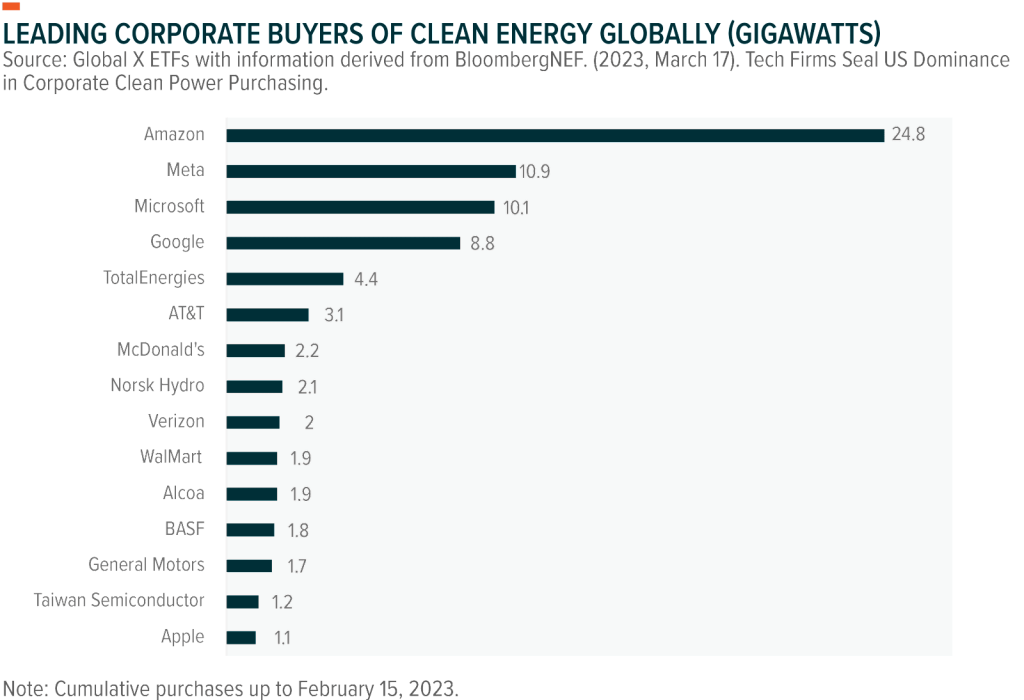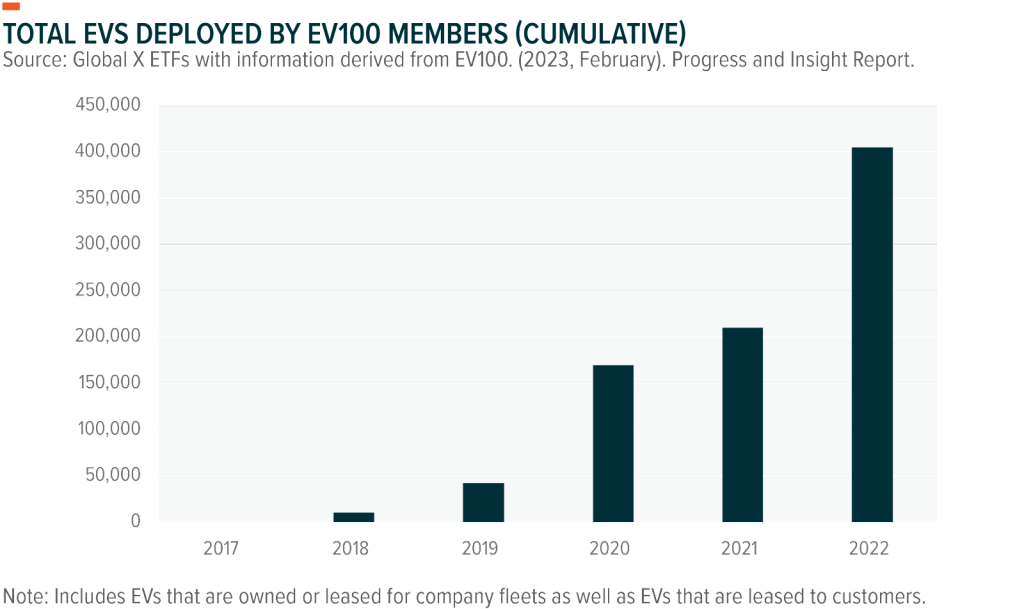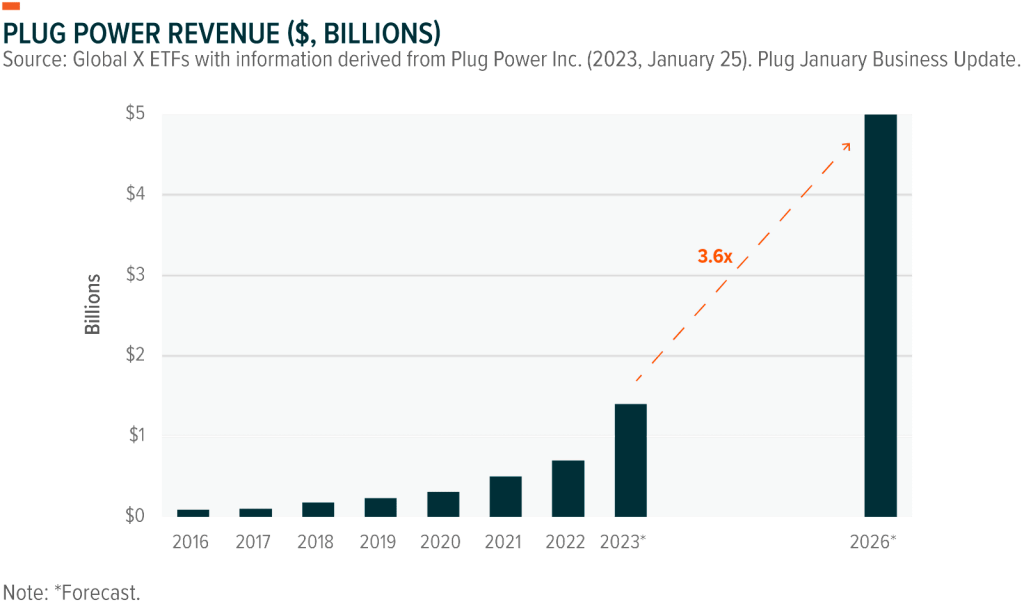By: Alec Lucas & Madeline Ruid
Many companies know the future needs to be green, so they’re accelerating their sustainability efforts to promote climate friendly operations and reduce their environmental footprints. Consumer demand for corporate sustainability is a major factor in these efforts. The public sector is another motivating factor, with many governments tightening environmental regulations. Over 40% of the world’s 2,000 largest companies, along with 133 countries and hundreds of cities, have set stringent net zero targets.1 Together, these corporations and government jurisdictions account for 88% of annual global emissions, meaning that if they bolster their sustainability efforts, they can substantially reduce global emissions.2
In this piece, we highlight how clean energy technologies, including wind and solar power systems, electric vehicles (EVs), and hydrogen fuel cells, are getting a boost from the private sector.
Key Takeaways
Corporations increasingly procuring their own renewable energy suggests that the growth outlooks for wind power and solar power can continue to strengthen.
Corporate coalitions and individual companies are racing to electrify transportation and delivery modalities, which could boost EV adoption.
Rising corporate interest in hydrogen as a way to decarbonize difficult-to-decarbonize segments, such as buildings, is advancing the development of the nascent green hydrogen industry.
Corporate Renewable Energy Procurements Advancing Wind and Solar Power
Over the past 10 years, many corporations have turned to procuring their own clean energy to decarbonize their day-to-day operations. Advancements in wind and solar power technologies and lowering costs have made this pathway increasingly viable. For many companies, clean energy procurement is part of their broader commitment to sustainability, in some cases spurred by like-minded peers. For example, as of March 2023, over 400 companies had joined RE100, a leading global corporate renewable energy initiative where members commit to reaching 100% renewable electricity.3 RE100 members are some of the largest corporate clean energy purchasers globally, including Meta, Google, and Microsoft.4
Currently the most common procurement avenue for corporations is through power purchase agreements (PPAs), which contract a specified amount of electricity from a renewable energy generator that owns and operates renewable energy projects. A key benefit of PPAs is that they allow corporations to reduce emissions without directly owning and operating clean power facilities onsite. In 2022, renewables developers secured a record-high 37 gigawatts (GW) of planned electricity capacity from corporate PPAs in 36 countries, an increase from 31.2GW in 2021.5 In total, corporations have signed around 150GW of PPAs since 2008, which is roughly equivalent to Canada’s total electricity capacity.6,7 The United States is the top PPA market, where PPAs account for 80% of the 77GW of contracted capacity by corporate buyers.8

Technology companies like Amazon and Meta are the top buyers of PPAs, although corporate purchases span a wide range of industries including the food and beverage, oil and gas, real estate, retail, finance, and telecommunications industries.9,10 Amazon, the world’s largest corporate buyer of renewable energy, wants to power operations with 100% renewable energy by 2025.11 As of February 2023, the company had secured over 24GW of renewable energy capacity from PPAs with a range of renewables developers, including AES Corporation and Brookfield Renewables.12,13,14 For example, in December 2022, Amazon signed a PPA with Brookfield Renewables for 600MW of wind and solar projects across three continents that will help cover electricity demand from data centers.15

Corporate renewable energy purchasers are also driving innovation in the renewable industry. Top buyers like Microsoft, Google, and Amazon have been instrumental in improving PPA structures, making them easier for smaller companies to implement. In addition, companies and renewables developers are working towards next-generation procurements where energy storage and other technologies can cover electricity demand with clean energy around the clock.
Additionally, some companies are even building their own onsite renewable energy systems, particularly rooftop and ground mounted solar photovoltaic systems. American retailers like Target and Walmart are leaders in onsite solar power procurements.16 For example, Walmart has worked with several renewables developers to install more than 180 megawatts (MW) of onsite solar across its stores, including more than 50 projects with EDP Renewables.17,18 The growth opportunity for on-site solar systems is immense, in our view. In the United States, rooftops of big box retailers alone could hold enough solar photovoltaic capacity to generate 84.4 terawatt hours (TWh) of solar power annually, which is equivalent to powering 8 million average U.S. households.19
Corporate Efforts to Electrify Transportation Intensify
Corporations are also making sweeping commitments to increase electric vehicle adoption. One way the private sector has shown its commitment to EV adoption is through a multinational coalition like EV100, which aims to make “electric transport the new normal by 2030.” To be a part of EV100, members publicly commit to one or more of the following pursuits by 2030: fleet electrification, charging station installation at all sites for staff/customers, or requiring electrified service contracts.
EV100, which began with 10 founding members in 2017, now consists of 127 companies, including Bank of America, Goldman Sachs, Deloitte, Lyft, Siemens, Bayer, and Unilever.20 As of the most recent EV100 progress report, members had deployed 404,608 EVs and more than 30,000 charging units at 3,200 locations.21 In total, members have commitments to purchase about 5.75 million EVs and construct 6,443 separate charging locations.22

AstraZeneca, an up-and-comer in the pharmaceutical space and EV100 member since 2019, has already converted 15% of its fleet to EVs.23 AstraZeneca’s involvement in EV100 is part of the company’s broader initiative to halve its value chain’s carbon footprint by 2030 and reduce emissions by 90% by 2045.24 EDF group, a French electric utility company that produces nuclear and renewable energy, is another prominent member of EV100. In 2022, EDF deployed 2,401 new EVs, more than any other EV100 member.25 EDF is an example of how companies in the cleantech or renewable energy segments aim to offer sustainable output from end to end, which in many cases necessitates EVs for shipping or other transportation.
Individual companies are also incorporating EVs into their sustainability frameworks. By the end of 2022, Amazon leveraged its partnership with Rivian to put more than 1,000 electric delivery trucks on the road.26 This initiative is likely only beginning, as Amazon committed to develop a fleet of 100,000 EVs by 2030.27 Similarly, Walmart recently entered into an agreement with Canoo to purchase 4,500 EVs for last-mile delivery services.28 The agreement also includes an option to purchase up to 10,000 units.29
Some companies are turning to EVs to electrify long-haul trucking. At the end of 2022 PepsiCo became the first company to operate the Tesla Semi, a new heavy-duty shipping EV with a 400-mile range. Pepsi preordered 100 Tesla Semis back in 2017 and aims to reduce direct emissions 75% by 2030.30
Nascent Green Hydrogen Industry Starts to Scale as Corporations Buy In
Corporations are experimenting with one of the newest clean technologies, hydrogen fuel cells, and the green hydrogen space is scaling rapidly as a result. A fuel cell creates the requisite conditions for hydrogen and oxygen to meet in an electrochemical reaction that generates electricity with only water vapor and heat as biproducts. When hydrogen is produced sustainably, fuel cells can produce clean energy on demand for difficult-to-decarbonize segments, such as buildings, vehicles, and heavy-duty equipment. Some corporations are eager to adopt fuel cells to electrify their equipment or to use it as a stationary power source.
Not all the fuel cell projects mentioned in this section currently harness green hydrogen, but that is a function of its rarity. Once sustainably sourced hydrogen becomes more readily available, fuel cells are calibrated to instantly take on a cleaner role in energy mixes.
Amazon made a splash in the hydrogen space in August 2022 by expanding its partnership with Plug Power, which dates to 2016.31 Amazon agreed to purchase 10,950 tons of green hydrogen per year from Plug Power for transportation and operational purposes.32 The deal is expected to activate in 2025 and supply Amazon with enough hydrogen to power 30,000 forklifts or 800 long-haul trucks.33 As part of the deal, Amazon will receive warrants to purchase up to 16 million Plug Power shares that vest if the ecommerce giant spends $2.1 billion on hydrogen products over the seven-year contract.34
Plug Power also recently expanded its partnership with Walmart. Plug Power helped Walmart develop a fleet of thousands of hydrogen-powered forklifts, and last year the Company signed an agreement to deliver up to 20 tons per day of liquified green hydrogen to power these machines.35 We expect corporate buyers to be the main catalyst for Plug Power’s revenue growth. Management believes revenue could grow from $701 million in 2022 to $5 billion by 2026, primarily because of these types of contracts.36

Furthermore, several companies have pilot programs to test fuel cell tech as a backup storage option. Honda operates a stationary fuel cell power station with 500 kilowatts (KW) of capacity that supplies energy to datacenters, and Microsoft has a similar project with 3MW of capacity.37,38 Honda’s project is scalable and is expected to remain in operation. Microsoft plans to install a commercialized version of the module at some point after the conclusion of the program.
Bloom Energy, a manufacturer and installer of fuel cell-based power generation platforms, lists Google, Panasonic, Adobe, IBM, and Morgan Stanley among its corporate customers.39 Bloom also has a longstanding relationship with Home Depot, which at the end of 2021 powered 204 stores with the help of Bloom’s fuel cells.40
In some cases, corporations’ interest in green hydrogen makes them innovation engines for hydrogen tech. In late 2022, Nel ASA announced that it would license some of GM’s fuel cell intellectual property to support commercialization of the company’s line of proton exchange membrane (PEM) electrolyzers.41 These machines use electricity to split water into hydrogen and oxygen, making them an essential conduit for green hydrogen production. Also in 2022, IBM and Meta independently announced that they would provide data support and computing capacity to assist in the physical development of hydrogen supply chains and work to drive down the cost of green hydrogen.42,43
Conclusion: Corporate Sustainability Efforts Bolster the CleanTech Theme
The CleanTech investment theme offers investors diverse opportunities to capture the corporate influence in the energy transition. We expect corporations will play an increasingly prominent role in the energy transition as they ramp up their decarbonization and sustainability efforts, spurred by government regulations and incentives as well as consumer pressure. We believe that this demand for corporate sustainability can help normalize green technologies and boost adoption, to the benefit of wind and solar power companies, EV producers, hydrogen fuel cell manufacturers, and green hydrogen producers.
FOOTNOTES
1. Net Zero Tracker. (n.d). Net Zero Numbers. Accessed on March 7, 2023.
2. Ibid.
3. RE100. (n.d.). RE100 Members. Accessed on March 20, 2023.
4. Ibid.
5. BloombergNEF. (2023, February 9). Corporations Brush Aside Energy Crisis, Buy Record Clean Power.
6. Ibid.
7. U.S. Energy Information Administration (EIA). (n.d.). international Overview – Electricity.
8. American Clean Power. (2023, January 18). Clean Energy Powers American Business.
9. Ibid.
10. BloombergNEF. (2023, March 17). Tech Firms Seal US Dominance in Corporate Clean Power Purchasing.
11. Amazon. (n.d.). Renewable Energy – Amazon Sustainability. Accessed on March 20, 2023.
12. BloombergNEF. (2023, March 17). Tech Firms Seal US Dominance in Corporate Clean Power Purchasing.
13. Daily Energy Insider. (2022, May 10). AES to provide 675MW of solar, battery power to Amazon under new Power Purchase Agreements.
14. PVTech. (2022, December 1). Brookfield Renewables secures 600MW PPA with Amazon.
15. Ibid.
16. Solar Energy Industries Association (SEIA). (2022, November 29). Solar Means Business: Tracking Solar Adoption By America’s Top Brands 2022.
17. Ibid.
18. EDP Renewables. (2021, September 13). EDPR signs more than 50 solar energy projects with Walmart.
19. Environment America. (2022, January 19). Solar on Superstores.
20. EV100. (2023, February). Progress and Insights Report.
21. Ibid.
22. Ibid.
23. Ibid.
24. AstraZeneca. (n.d.). Ambition Zero Carbon. Accessed on March 27, 2023.
25. EV100. (2023, February). Progress and Insights Report.
26. Amazon. (2022, November 7). Amazon’s new electric vans will be making deliveries in over 100 U.S. cities this holiday season.
27. Ibid.
28. Canoo. (2022, July 12). Walmart to Purchase 4,500 Canoo Electric Delivery Vehicles to be Used for Last Mile Deliveries in Support of Its Growing eCommerce Business.
29. Ibid.
30. Thomas. (2022, May 25). Pepsi Plans to Electrify Its Vehicle Fleet to Meet Sustainability Goals.
31. Utility Dive. (2022, August 29). Amazon expands hydrogen supplier deal with Plug Power as it strives for carbon neutrality.
32. Ibid.
33. Ibid.
34. Ibid.
35. Plug Power. (2022, April 19). Plug Supplies Walmart with Green Hydrogen to Fuel Retailer’s Fleet of Material Handling Lift Trucks.
36. Plug Power. (2023, January 25). Plug January Business Update.
37. CleanTechnica. (2023, March 6). Honda Pushes Forward With New Stationary Hydrogen Power Station For Backup Power.
38. Datacenter Dynamics. (2022, July 29). Microsoft builds 3MW hydrogen fuel cell backup power plant.
39. Bloom Energy. (n.d.). Bloom Energy Case Studies. Accessed on March, 27 2023.
40. Home Depot. (2022, October). 2022 ESG Report.
41. Nel. (2022, November 16). Nel and GM collaborate on cost competitive renewable hydrogen production.
42. IBM. (2022, February 22). Worley, ABB, and IBM to collaborate to create an end-to-end green hydrogen solution.
43. Datacenter Dynamics. (2022, April 19). Facebook parent Meta will release catalyst data to help make hydrogen fuel more cheaply.
Originally Posted on April 5th, 2023 on the GlobalX blog.
PHOTO CREDIT: https://www.shutterstock.com/g/chombosan
Via SHUTTERSTOCK
Disclosure
This material represents an assessment of the market environment at a specific point in time and is not intended to be a forecast of future events, or a guarantee of future results. This information is not intended to be individual or personalized investment advice and should not be used for trading purposes. Please consult a financial advisor or tax professional for more information.
Investing involves risk, including the possible loss of principal.



